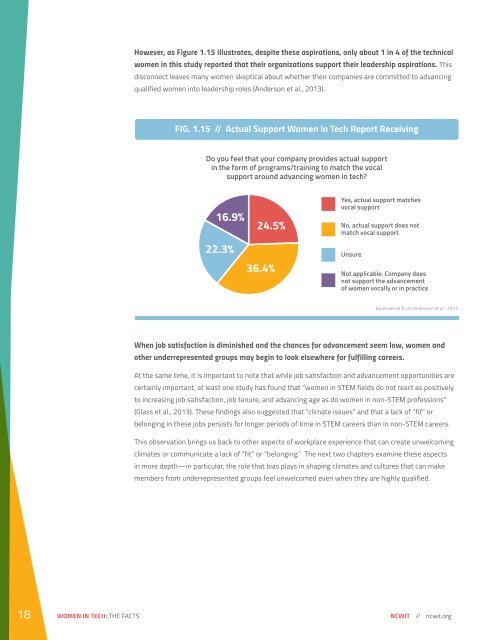WOMEN IN TECH THE FACTS
womenintech_facts_fullreport_05132016
womenintech_facts_fullreport_05132016
You also want an ePaper? Increase the reach of your titles
YUMPU automatically turns print PDFs into web optimized ePapers that Google loves.
However, as Figure 1.15 illustrates, despite these aspirations, only about 1 in 4 of the technical<br />
women in this study reported that their organizations support their leadership aspirations. This<br />
disconnect leaves many women skeptical about whether their companies are committed to advancing<br />
qualified women into leadership roles (Anderson et al., 2013).<br />
FIG. 1.15 // Actual Support Women in Tech Report Receiving<br />
Do you feel that your company provides actual support<br />
in the form of programs/training to match the vocal<br />
support around advancing women in tech?<br />
16.9%<br />
22.3%<br />
24.5%<br />
36.4%<br />
Yes, actual support matches<br />
vocal support<br />
No, actual support does not<br />
match vocal support<br />
Unsure<br />
Not applicable. Company does<br />
not support the advancement<br />
of women vocally or in practice<br />
Rerendered from Anderson et al., 2013<br />
When job satisfaction is diminished and the chances for advancement seem low, women and<br />
other underrepresented groups may begin to look elsewhere for fulfilling careers.<br />
At the same time, it is important to note that while job satisfaction and advancement opportunities are<br />
certainly important, at least one study has found that “women in STEM fields do not react as positively<br />
to increasing job satisfaction, job tenure, and advancing age as do women in non-STEM professions”<br />
(Glass et al., 2013). These findings also suggested that “climate issues” and that a lack of “fit” or<br />
belonging in these jobs persists for longer periods of time in STEM careers than in non-STEM careers.<br />
This observation brings us back to other aspects of workplace experience that can create unwelcoming<br />
climates or communicate a lack of “fit” or “belonging.” The next two chapters examine these aspects<br />
in more depth—in particular, the role that bias plays in shaping climates and cultures that can make<br />
members from underrepresented groups feel unwelcomed even when they are highly qualified.<br />
18 <strong>WOMEN</strong> <strong>IN</strong> <strong>TECH</strong>: <strong>THE</strong> <strong>FACTS</strong> NCWIT // ncwit.org


